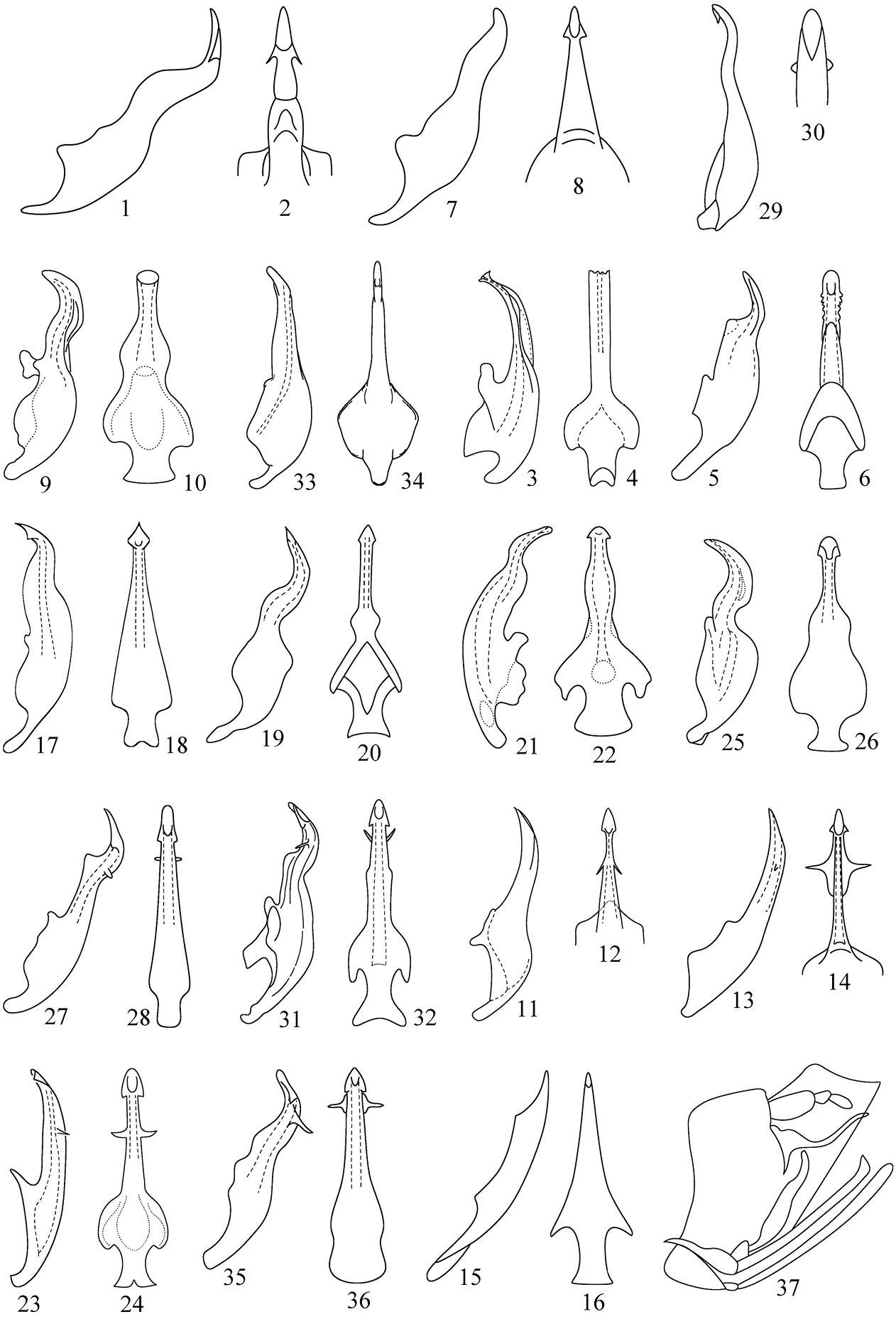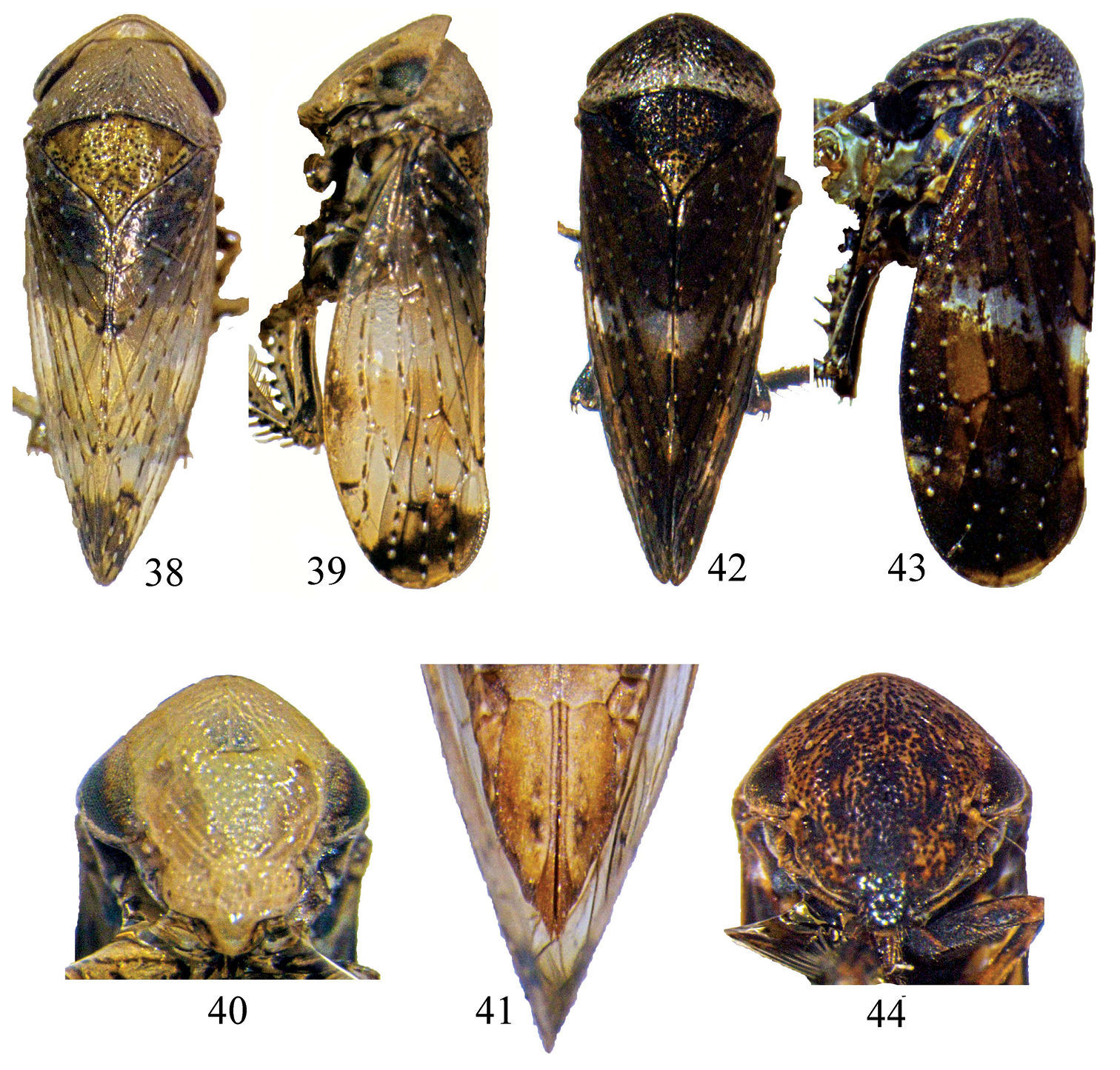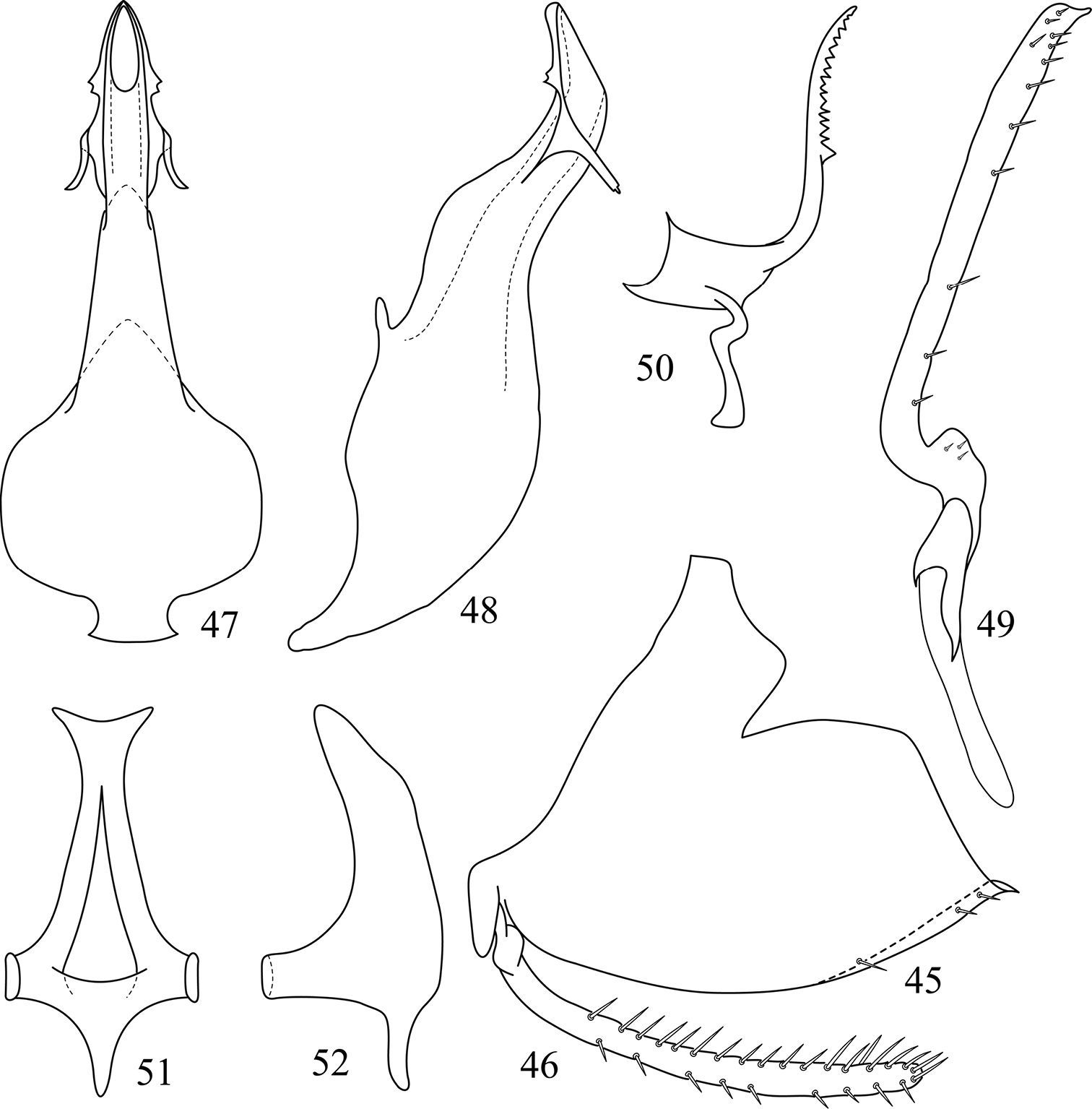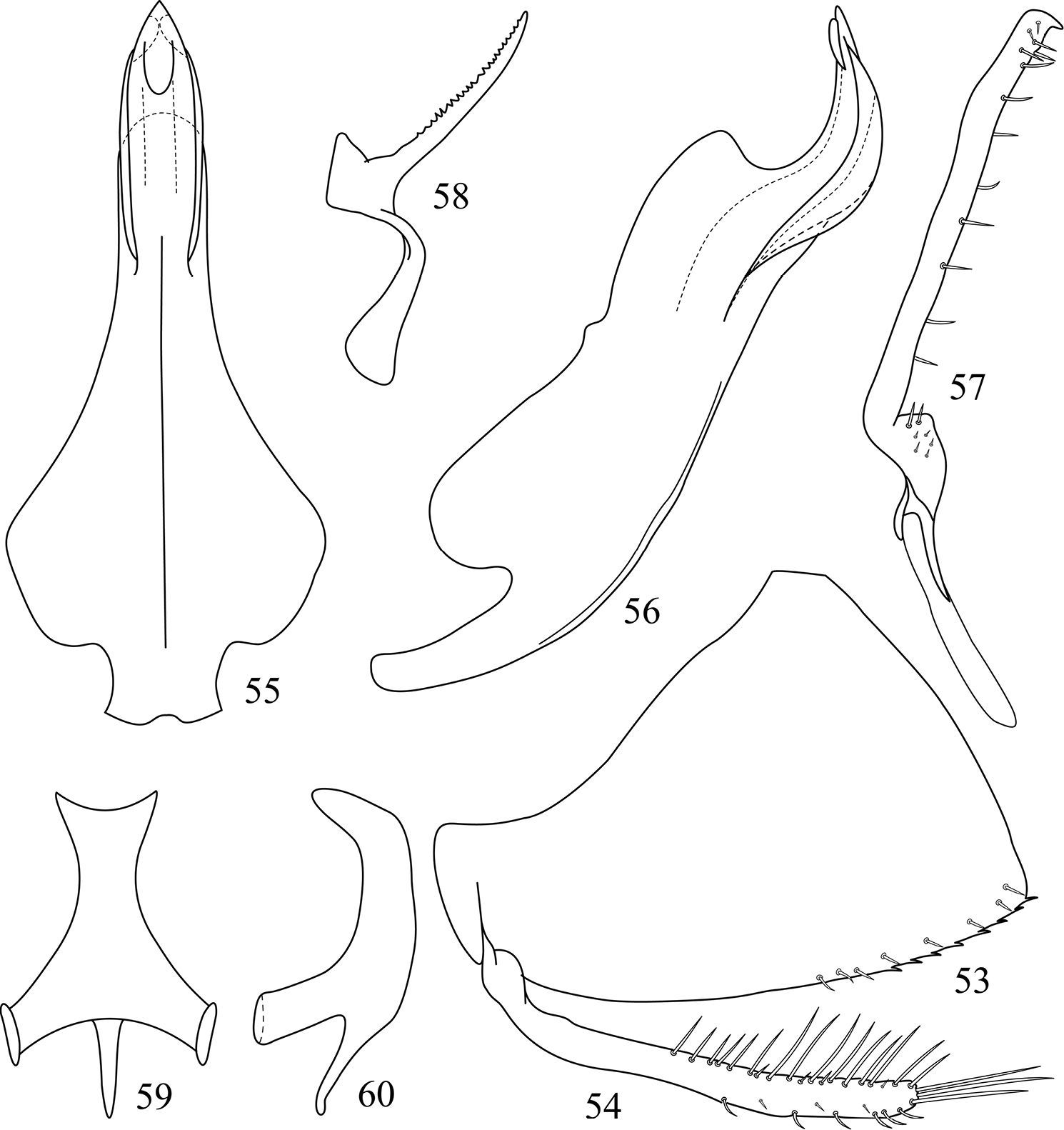(C) 2011 Hu Li. This is an open access article distributed under the terms of the Creative Commons Attribution License, which permits unrestricted use, distribution, and reproduction in any medium, provided the original author and source are credited.
For reference, use of the paginated PDF or printed version of this article is recommended.
Two new species Pedionis (Pedionis) nankunshanensis Li, Dai & Li sp. n. and Pedionis (Pedionis) tabulatus Li, Dai & Li sp. n. from China are described and illustrated. A key is given to separate all species of this genus (except Pedionis (Pedionis) oeroe and Pedionis (Pedionis) thyia).
Hemiptera, Macropsinae, Pedionis, new species, taxonomy, distribution, China
The leafhopper genus Pedionis belongs to the tribe Macropsini, subfamily Macropsinae (Hemiptera: Cicadellidae) and was established by
Species of Pedionis are mainly distributed in the Oriental region, and almost half of them (all belong to subgenus Pedionis) are found in southern of China (Oriental region) and most Pedionis species are associated with shrubs and trees.
In this paper, two new Chinese species of the genus from Guizhou and Guangdong Province are described and illustrated. 23 species of the genus and a key to species from the world is provided (except Pedionis (Pedionis) oeroe and Pedionis (Pedionis) thyia). The type specimens of the new species are deposited in the Institute of Entomology, Guizhou University, Guiyang, China (GUGC).
TaxonomyPediopsis garuda Distant, 1916.
Following
Pediopsis garuda Distant, 1916: 239.
Following
Oriental region, Palaearctic region, Northern Australia.
Macropsis thyia Kirkaldy, 1907: 36.
Following
Northern Australia.
Notes: Thespecies Pedionis (Pedionis) oeroe should belong to the subgenus Pedionis
by tegmina with only 2 subapical cells and veins dark fuscous
multiannulate with whitish according to the original description, but
no male genitalia manuscript (
| 1 | Aedeagal shaft without any processes (Figs 9–10, 15–16, 33–34, 37) | 2 |
| – | Aedeagal shaft with 1–2 processes (Figs 1–8, 11–14, 17–32, 35–36, 47–48, 55–56) | 5 |
| 2 | Aedeagus broader basally and tapering apically (Figs 9–10, 33–34) | 3 |
| – | Aedeagus less broader basally and about the end (Figs 15–16, 37) | 4 |
| 3 | Gonopore opening on the apex of adeagal shaft (Figs 9–10) | Pedionis (Pedionis) curvata |
| – | Gonopore opening on the subapical of adeagal shaft (Figs 33–34) | Pedionis (Pedionis) venosa |
| 4 | Aedeagal shaft strongly sinuated (Fig. 37) | Pedionis (Pedionis) minuta |
| – | Aedeagal shaft less sinuated and with protuberance in middle-dorsal aspect (Figs 15–16) | Pedionis (Pedionis) koghiensis |
| 5 | Aedeagal shaft with one pair of processes (Figs 1–8, 17–22, 25–26, 29–30) | 6 |
| – | Aedeagal shaft with two pairs of processes (Figs 11–14, 23–24, 27–28, 31–32, 35–36, 47–48, 55–56) | 14 |
| 6 | This one pair of processes produced on the apex of aedeagal shaft (Figs 3–4, 17–22, 25–26, 29–30) | 7 |
| – | This one pair of processes produced on the subapical of aedeagal shaft (Figs 1–2, 5–8) | 12 |
| 7 | The processes situated on the ventral margin of apical aedeagal shaft (Figs 3–4, 17–22, 25–26) | 8 |
| – | The processes situated on the dorsal margin of apical aedeagal shaft (Figs 29–30) | Pedionis (Pedionis) stigma |
| 8 | The apex of aedeagal as arrow-like (Figs 17–20) | 9 |
| – | The apex of aedeagal as curved-like or serrated (Figs 3–4, 21–22, 25–26) | 10 |
| 9 | Aedeagal shaft with a bulbous (Figs 19–20) | Pedionis (Pedionis) mecota |
| – | Aedeagal shaft without any bulbous, tapering apically (Figs 17–18) | Pedionis (Pedionis) lii |
| 10 | Apex of aedeagal shaft as curved-like (Figs 21–22, 25–26) | 11 |
| – | Apex of aedeagal shaft as serrated-like (Figs 3–4) | Pedionis (Pedionis) cherraensis |
| 11 | Aedeagal shaft with a bulge nearly base, the lateral aspect of aedeagus strongly sinuated (Figs 25–26) | Pedionis (Pedionis) serrate |
| – | Aedeagal shaft with a bulge nearly middle, the lateral aspect of aedeagus less sinuated (Figs 21–22) | Pedionis (Pedionis) palniensis |
| 12 | The pair processes wide and as serrated (Figs 5–6) | Pedionis (Pedionis) clypellata |
| – | The pair processes narrow and as lamella (Figs 1–2, 7–8) | 13 |
| 13 | Aedeagal shaft with a constriction in middle, the lateral aspect of aedeagus strongly sinuated (Figs 1–2) | Pedionis (Pedionis) astrala |
| – | Aedeagal shaft without any constriction in any position, the lateral aspect of aedeagus less sinuated (Figs 7–8) | Pedionis (Pedionis) contrasta |
| 14 | Two pairs of processes without connection, separated (Figs 23–24, 27–28, 31–32, 35–36, 55–56) | 15 |
| – | Two pairs of processes with a membranous connection (Figs 11–14, 47–48) | 19 |
| 15 | The first pair of processes produced on the dorsal margin of apical aedeagal shaft, the second wide (Figs 55–56) | Pedionis (Pedionis) tabulatus Li, Dai & Li sp. n. |
| – | The first pair of processes produced on the ventral margin of apical aedeagal shaft, the second narrow (Figs 23–24, 27–28, 31–32, 35–36) | 16 |
| 16 | The second pair of processes closely to the first (Figs 35–36) | Pedionis (Pedionis) yunnana |
| – | The second pair of processes away from the first (Figs 23–24, 27–28, 31–32) | 17 |
| 17 | Dorsal aspect of aedeagal shaft with protuberance in middle (Figs 27–28, 31–32) | 18 |
| – | Dorsal aspect of aedeagal shaft without protuberance (Figs 23–24) | Pedionis (Pedionis) rufoscutallata |
| 18 | Aedeagal shaft with a bulge nearly middle, the second pair of processes towards dorsal aspect (Figs 31–32) | Pedionis (Pedionis) sumatrana |
| – | Aedeagal shaft without a bulge nearly middle, the second pair of processes towards ventral aspect (Figs 27–28) | Pedionis (Pedionis) spinata |
| 19 | The first pair of processes produced on the dorsal margin of aedeagal shaft as serrated, the second have reflexed ventral aspect view (Figs 47–48) | Pedionis (Pedionis) nankunshanensis Li, Dai & Li sp. n. |
| – | The first pair of processes produced on the ventral margin of aedeagal shaft, the second have no reflexed ventral aspect view (Figs 11–14) | 20 |
| 20 | The second pair of processes wide basally, aedeagal shaft strongly sinuated (Figs 13–14) | Pedionis (Pedionis) kagoshimensis |
| – | The second pair of processes slender, aedeagal shaft less sinuated (Figs 11–12) | Pedionis (Pedionis) garuda |
Aedeagus of Pedionis species, lateral view and ventral view. 1, 2 Pedionis astrala Hamilton 3, 4 Pedionis cherraensis Viraktamath 5, 6 Pedionis clypellata Huang & Viraktamath 7, 8 Pedionis contrasta Hamilton 9, 10 Pedionis curvata Viraktamath 11, 12 Pedionis garuda (Distant) 13, 14 Pedionis kagoshimensis (Matsumura) 15, 16 Pedionis koghiensis (Evans) 17, 18 Pedionis lii Zhang & Viraktamath 19, 20 Pedionis mecota Liu & Zhang 21, 22 Pedionis palniensis Viraktamath 23, 24 Pedionis rufoscutallata Huang & Viraktamath 25, 26 Pedionis serrate Viraktamath 27, 28 Pedionis spinata Zhang&Viraktamath 29, 30 Pedionis stigma Kouh 31, 32 Pedionis sumatrana Viraktamath 33, 34 Pedionis venosa Hamilton 35, 36 Pedionis yunnana Zhang & Viraktamath 37 Pedionis minuta (Evans). (1–2, 7–8, 13–14 after
Pedionis (Pedionis) nankunshanensis Li, Dai & Li sp. n. 38 Dorsal view, (♂) 39 Lateral view, (♂) 40 Facial view, (♂) 41 Seventh sternite ventral view. 42–44 Pedionis (Pedionis) tabulatus Li, Dai & Li sp. n. 42 Dorsal view, (♂) 43 Lateral view, (♂) 44 Facial view, (♂).
urn:lsid:zoobank.org:act:F6618549-C9A5-4430-8458-43FC0B39DDB0
http://species-id.net/wiki/Pedionis_(Pedionis)_nankunshanensis
Figs 45–52Body yellowish-brown (Fig. 38). The vertex inverted “V” shaped, as wide as pronotum (Fig. 38), weakly curved in profile, slightly away from the pronotum (Fig. 39); eyes brown; ocelli located between the eyes, its surrounding yellow, below gray (Fig. 40). The pronotum pale-yellow, anterior margin curved prominent, posterior margin slightly concave. Scutellum triangular, yellowish, scatter dark notches, base-lateral sides gray, post-middle region with one deep notch (Fig. 38). Forewings hyaline, end area chocolate-brown, veins fuscous white spots distinctly (Fig. 39).
Pedionis (Pedionis) nankunshanensisLi, Dai & Li sp. n. 45 Male pygofer side, lateral view 46 Subgenital plate, lateral view 47 Aedeagus, ventral view 48 Aedeagus, lateral view 49 Style, dorsal view 50 Dorsal connective 51 Connective, dorsal view 52 Connective, lateral view.
Pygofer broad, the apex acute in lateral view and produced several setae on the ventral margin (Fig. 45). Subgenital plate slender with many marginal setae (Fig. 46). Aedeagus broader basally, shaft strongly sinuate in lateral view, apex tapering, and with two pairs of processes, the apical processes located dorsal margin, serrated, the subapical processes located lateral margin, reflexed in ventral aspect view, apex digitation, the processes with a membranous connection (Figs 47–48). Style parallel-margined and angled on the apical third, the apex obliquely truncate, produced a narrow truncate process on dorsal margin (Fig. 49). Dorsal connective complex and sinuate, apex bulbous, produced a long process from caudal margin to dorsad, and mesal-ventral apical margin minutely serrated (Fig. 50). Connective broader basally, a finger-like protrusion in middle, both sides bent to the inside (Figs 51–52).
Similar to male in coloration and appearance. The seventh sternite 1.5 times the sixth sternite, carved in middle-posterior margin (Fig. 41).
Length (including tegmen): ♂, 3.2–3.5 mm;♀, 3.8–4.0 mm.
Holotype ♂, China: Guangdong Prov., Nankunshan, 24 August 2010, collected by Hu Li (GUGC). Paratypes: 1♂1♀, same data as holotype; 2♀♀, Guangdong Prov., Nankunshan, 22 August 2010, collected by Junqiang Ni (GUGC).
This species is similar to Pedionis (Pedionis) yunnana Zhang & Viraktamath, 2010 but can be distinguished from the latter by having the apical processes on aedeagal shaft serrated; the subapical processes reflexed ventral aspect view, apex digitations.
The new species name refers to the type locality.
urn:lsid:zoobank.org:act:F3EBE21A-C693-4E00-94EA-B5FBE7706B78
http://species-id.net/wiki/Pedionis_(Pedionis)_tabulatus
Figs 53–60Body coloration and appearance similar to Pedionis (Pedionis) lii Zhang & Viraktamath, 2010 but more dark and pronotum slightly concave, with a white belt on posterior margin (Figs 42–44).
Pygofer broad, obliquely truncate, the apex obtuse in lateral view, produced regularly spike-spines and setae on the ventral margin (Fig. 53). Subgenital plate slender with many setae, several especially long in the end (Fig. 54). Aedeagus broader basally, shaft strongly sinuated, angled heavily on apical third and bulge occurred in middle-dorsal in lateral view; apex tapering, and with two pairs of processes, the apical processes small and produced on dorsal margin, the subapical processes located lateral margin, broad as lamella (Figs 55–56). Style (Fig. 57), dorsal connective (Fig. 58) and connective (Figs 59–60) similar to Pedionis (Pedionis) nankunshanensis sp. n. but differs by mesal-dorsal serration.
Unknown.
Length (including tegmen): ♂, 5.2mm.
Pedionis (Pedionis) tabulatusLi, Dai & Li sp. n. 53 Male pygofer side, lateral view 54 Subgenital plate, lateral view 55 Aedeagus, ventral view 56 Aedeagus, lateral view 57 Style, dorsal view 58 Dorsal connective 59 Connective, dorsal view 60 Connective, lateral view.
Holotype ♂, China: Guizhou Prov., Kuankuoshui Nature Reserve, Baishaogou, 7 June 2010, collected by Hu Li (GUGC).
This species is similar to Pedionis (Pedionis) yunnana Zhang & Viraktamath, 2010 but differs markedly from the latter in having the apical processes on aedeagal shaft occurred in dorsal margin; the subapical processes broad, lamella-like; the pygofer with regularly spike-spines and setae on the ventral margin.
The species name is derived from the Latin words “tabulatus”, indicating the subapical processes of adeagal shaft are lamella-like.
We are very grateful to Prof. K. G. A. Hamilton (Eastern Cereal and Oilseed Research Centre, Ottawa, Ontario, Canada) and Dr. Shigeru Okudera (Entomological Laboratory, Faculty of Agriculture, Kyushu University, Fukuoka, Japan) for providing important literatures. We also thank Dr. Ivailo Stoyanov (Editorial Secretary of Zookeys) for helpful suggestions. The project was supported by the National Natural Science Foundatation of China (31000952).










